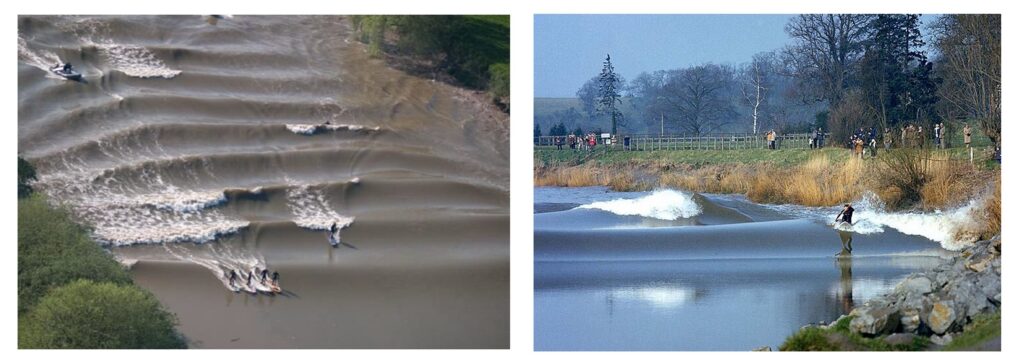| Landscape Architecture
2025 SPRING EQUINOX: LARGE SEVERN BORES PREDICTED
March 31st this year is given as a four-star bore. The Severn Bore is one of Britain’s few truly spectacular natural phenomena. It is a large surge wave that can be seen in the estuary of the River Severn, where the tidal range is the 2nd highest in the world, being as much as 50 feet (approx. 15.4m). The best places to observe it are in the narrow channel just south of Gloucester (times at Minsterworth, Stonebench and Over Bridge given below).



As many as 60 bores occur throughout the world where the river estuary is the right shape and the tidal conditions are such that the wave is able to form. The Severn Bore is one of the biggest in the world but bores also occur on the Seine and Gironde in France, on the Indus, Hooghly and Brahmaputra in India, on the Amazon in Brazil and the Qiantang in China.
The shape of the Severn estuary is such that the water is funnelled into an increasingly narrow channel as the tide rises, thus forming the large wave. The river’s course takes it past Avonmouth where it is approximately 5 miles wide, then past Chepstow and Aust, then Lydney and Sharpness where it is approximately 1 mile wide, and soon the river is down to a width of a hundred metres. By the time the river reaches Minsterworth it is less than 30m across, maintaining this width all the way to Gloucester.
As well as the width of the river decreasing rapidly, then so does the depth of the river also change rapidly, thereby forming a funnel shape. Therefore as the incoming tide travels up the estuary, it is routed into an ever decreasing channel. Consequently the surge wave or bore is formed.
The bore is best seen at Stonebench, near Elmore, on the east bank, or at Minsterworth on the west bank. It can also be seen at Over Bridge. As a natural spectacle, in some respects, the Bore is best viewed (and heard) at night when there is less chance of powerboats etc on it, and/or just in front of it. The engine noise masks the sound of the wave and their wake(s) diminish the spectacle of a single wave rapidly advancing up a smooth river. To a certain extent it can still be seen in the dark and many spectators have powerful torches anyway.
For me, the amazing change in the river landscape before and after the bore is worth witnessing, as well as the power of the bore wave. The best book on the subject in my opinion is Fred Rowbotham’s The Severn Bore.
Bob Moore


